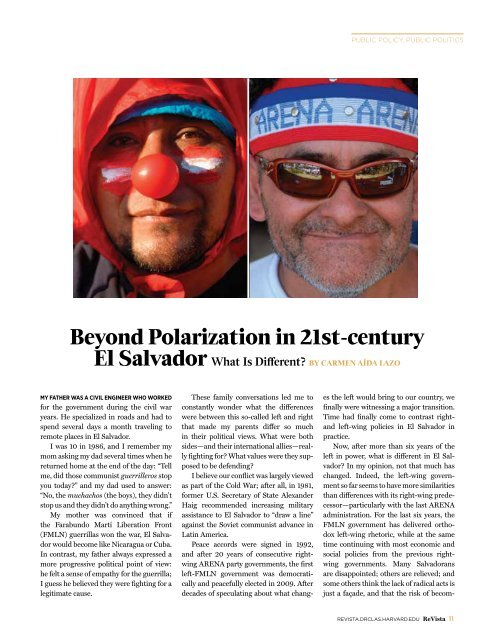EL SALVADOR
8clowSgZh
8clowSgZh
Create successful ePaper yourself
Turn your PDF publications into a flip-book with our unique Google optimized e-Paper software.
PUBLIC POLICY, PUBLIC POLITICS<br />
Beyond Polarization in 21st-century<br />
El Salvador What Is Different? BY CARMEN AÍDA LAZO<br />
MY FATHER WAS A CIVIL ENGINEER WHO WORKED<br />
for the government during the civil war<br />
years. He specialized in roads and had to<br />
spend several days a month traveling to<br />
remote places in El Salvador.<br />
I was 10 in 1986, and I remember my<br />
mom asking my dad several times when he<br />
returned home at the end of the day: “Tell<br />
me, did those communist guerrilleros stop<br />
you today?” and my dad used to answer:<br />
“No, the muchachos (the boys), they didn’t<br />
stop us and they didn’t do anything wrong.”<br />
My mother was convinced that if<br />
the Farabundo Martí Liberation Front<br />
(FMLN) guerrillas won the war, El Salvador<br />
would become like Nicaragua or Cuba.<br />
In contrast, my father always expressed a<br />
more progressive political point of view:<br />
he felt a sense of empathy for the guerrilla;<br />
I guess he believed they were fighting for a<br />
legitimate cause.<br />
These family conversations led me to<br />
constantly wonder what the differences<br />
were between this so-called left and right<br />
that made my parents differ so much<br />
in their political views. What were both<br />
sides—and their international allies—really<br />
fighting for? What values were they supposed<br />
to be defending?<br />
I believe our conflict was largely viewed<br />
as part of the Cold War; after all, in 1981,<br />
former U.S. Secretary of State Alexander<br />
Haig recommended increasing military<br />
assistance to El Salvador to “draw a line”<br />
against the Soviet communist advance in<br />
Latin America.<br />
Peace accords were signed in 1992,<br />
and after 20 years of consecutive rightwing<br />
ARENA party governments, the first<br />
left-FMLN government was democratically<br />
and peacefully elected in 2009. After<br />
decades of speculating about what changes<br />
the left would bring to our country, we<br />
finally were witnessing a major transition.<br />
Time had finally come to contrast rightand<br />
left-wing policies in El Salvador in<br />
practice.<br />
Now, after more than six years of the<br />
left in power, what is different in El Salvador?<br />
In my opinion, not that much has<br />
changed. Indeed, the left-wing government<br />
so far seems to have more similarities<br />
than differences with its right-wing predecessor—particularly<br />
with the last ARENA<br />
administration. For the last six years, the<br />
FMLN government has delivered orthodox<br />
left-wing rhetoric, while at the same<br />
time continuing with most economic and<br />
social policies from the previous rightwing<br />
governments. Many Salvadorans<br />
are disappointed; others are relieved; and<br />
some others think the lack of radical acts is<br />
just a façade, and that the risk of becom-<br />
REVISTA.DRCLAS.HARVARD.EDU ReVista 11


